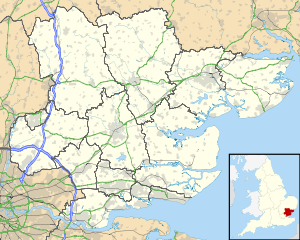
Back قتلهای باغ کاخ سفید FA Omicidi della White House Farm Italian Morden vid White House Farm Swedish
 White House Farm, 2007 | |
White House Farm, Essex | |
| Date | 7 August 1985 |
|---|---|
| Location | White House Farm, near Tolleshunt D'Arcy, Essex, England |
| Coordinates | 51°45′33″N 0°48′12″E / 51.7591°N 0.8032°E |
| Deaths |
|
| Convicted | Jeremy Bamber (then 24), convicted on 28 October 1986 of five counts of murder |
| Sentence | Whole-life order |
The White House Farm murders took place near the village of Tolleshunt D'Arcy, Essex, England, during the night of 6–7 August 1985. Nevill and June Bamber were shot and killed inside their farmhouse at White House Farm along with their adopted daughter, Sheila Caffell, and Sheila's six-year-old twin sons, Daniel and Nicholas Caffell. The only surviving member of the immediate family was the adopted son, Jeremy Bamber, then aged 24, who said he had been at home a few miles away when the shooting took place.[1]
Police initially believed that Sheila, who had been diagnosed with schizophrenia, had fired the shots before turning the gun on herself, but weeks after the murders, Jeremy's ex-girlfriend told police that he had implicated himself. The prosecution argued that, motivated by a large inheritance, Jeremy had shot the family with his father's semi-automatic rifle, then placed the gun in Sheila's hands to make the deaths look like a murder–suicide. A silencer, the prosecution said, was on the rifle and would have made it too long, they argued, for Sheila's fingers to reach the trigger to shoot herself. Jeremy was convicted of five counts of murder in October 1986 by a 10–2 majority verdict, sentenced to a minimum of twenty-five years, and informed in 1994 that he would never be released. The Court of Appeal upheld the verdict in 2002.[2]
Jeremy protested his innocence throughout, although his extended family remained convinced of his guilt. Between 2004 and 2012, his lawyers submitted several unsuccessful applications to the Criminal Cases Review Commission, arguing that the silencer might not have been used during the killings, that the crime scene might have been damaged then reconstructed, that crime scene photographs were taken weeks after the murders and that the time of Sheila's death had been miscalculated.[3][4]
A key issue was whether Jeremy had received a call from his father on the night of the murder to tell him Sheila had "gone berserk" with a gun. Jeremy said that he did, that he alerted police and that Sheila fired the final shot while he and the officers were standing outside the house. It became a central plank of the prosecution's case that the father had made no such call and that the only reason Jeremy would have lied about it — indeed, the only way he could have known about the shootings when he alerted the police — was that he was the killer himself.[5]
- ^ [2002] EWCA Crim 2912; Lee 2015, pp. xiii–xv.
- ^ [2002] EWCA Crim 2912.
- ^ Smith 2010, 18–22; for extended family, 19–20.
- ^ "Murder most foul, but did he do it?". The Times (editorial). 18 March 2001. Archived from the original on 3 October 2006. Retrieved 5 August 2020.
- ^ [2002] EWCA Crim 2912, 153.
